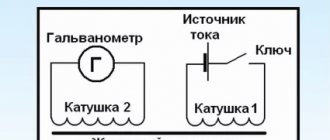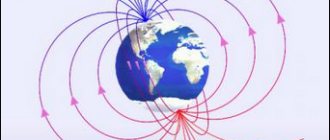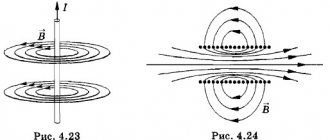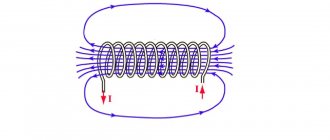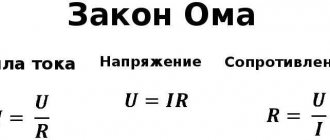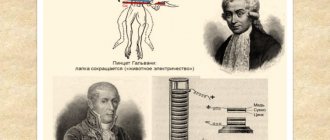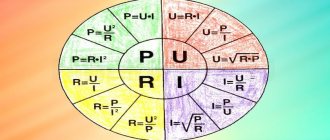What better way to read about the basics on a Monday evening? electrodynamics. That's right, you can find many things that are better. However, we still suggest you read this article. It doesn’t take much time, and useful information will remain in the subconscious. For example, during an exam, under stress, it will be possible to successfully extract Faraday’s law from the depths of memory. Since there are several Faraday laws, let us clarify that here we are talking about Faraday’s law of induction.
Electrodynamics is a branch of physics that studies the electromagnetic field in all its manifestations.
This includes the interaction of electric and magnetic fields, electric current, electromagnetic radiation, and the influence of the field on charged bodies.
Here we do not aim to consider all electrodynamics. God forbid! Let's take a better look at one of its basic laws, which is called Faraday's law of electromagnetic induction .
Michael Faraday (1791-1867)
The phenomenon of electromagnetic induction
Electromagnetic induction is the phenomenon of the occurrence of current in a closed conductive circuit when the magnetic flux passing through it changes.
The phenomenon of electromagnetic induction was discovered by M. Faraday.
Faraday's experiments
- Two coils were wound on one non-conducting base: the turns of the first coil were located between the turns of the second. The turns of one coil were closed to a galvanometer, and the second was connected to a current source. When the key was closed and current flowed through the second coil, a current pulse arose in the first. When the switch was opened, a current pulse was also observed, but the current through the galvanometer flowed in the opposite direction.
- The first coil was connected to a current source, the second, connected to a galvanometer, moved relative to it. As the coil approached or moved away, the current was recorded.
- The coil is closed to the galvanometer, and the magnet moves - moves in (extends) - relative to the coil.
Experiments have shown that induced current occurs only when the magnetic induction lines change. The direction of the current will be different when the number of lines increases and when they decrease.
The strength of the induction current depends on the rate of change of the magnetic flux. The field itself may change, or the circuit may move in a non-uniform magnetic field.
Explanations of the occurrence of induction current
Current in a circuit can exist when external forces act on free charges. The work done by these forces to move a single positive charge along a closed loop is equal to the emf. This means that when the number of magnetic lines through the surface limited by the contour changes, an emf appears in it, which is called the induced emf.
Electrons in a stationary conductor can only be driven by an electric field. This electric field is generated by a time-varying magnetic field. It is called an eddy electric field . The concept of a vortex electric field was introduced into physics by the great English physicist J. Maxwell in 1861.
Properties of the vortex electric field:
- source – alternating magnetic field;
- detected by the effect on the charge;
- is not potential;
- the field lines are closed.
The work of this field when moving a single positive charge along a closed circuit is equal to the induced emf in a stationary conductor.
Practical use
Electrolysis and Faraday's laws that explain it have wide practical applications. For the first time in history, this phenomenon was used by the Russian physicist Jacobi. He created prints of figures for the decoration of St. Isaac's Cathedral in St. Petersburg, using a method called galvanoplasty. This method allows you to obtain high-quality copies of metal figures.
Another area of using electrolysis in chemistry is the production of high-purity metals. In particular, magnesium, aluminum, sodium and calcium can be extracted in this way. Typically, molten ore is subjected to electrolysis.
Using a technology such as electroplating, it is possible to coat a metal part with a thin and uniform shell of a certain substance. This method creates protective coatings.
Using electrolysis, it is possible to purify metals from impurities, increasing their degree of purity. You can also obtain concentrated alkalis and acids.
Electrolysis is beneficial not only due to the fact that a substance is deposited on the electrode, but also due to the fact that gas is released at the anode. This technological process makes it possible to produce, for example, hydrogen.
Electrochemistry has also found its application in wastewater treatment. Chemical decomposition removes contaminants from the liquid, making it suitable for reuse.
Magnetic flux
Magnetic flux through the area \( S \) of the contour is called a scalar physical quantity equal to the product of the magnitude of the magnetic induction vector \( B \), the surface area \( S \), penetrated by this flux, and the cosine of the angle \ ( \alpha \) between the direction of the magnetic induction vector and the normal vector (perpendicular to the plane of a given surface):
The designation is \( \Phi \), the SI unit is weber (Wb).
A magnetic flux of 1 weber is created by a uniform magnetic field with an induction of 1 T through a surface of 1 m2 located perpendicular to the magnetic induction vector:
Magnetic flux can be visualized as a value proportional to the number of magnetic lines passing through a given area.
Depending on the angle \( \alpha \) the magnetic flux can be positive (\( \alpha \) < 90°) or negative (\( \alpha \) > 90°). If \( \alpha \) = 90°, then the magnetic flux is 0.
You can change the magnetic flux by changing the area of the circuit, the field induction module, or the location of the circuit in the magnetic field (by rotating it).
In the case of a non-uniform magnetic field and a non-flat contour, the magnetic flux is found as the sum of the magnetic fluxes penetrating the area of each of the sections into which a given surface can be divided.
Features of the processes occurring at the cathode and anode
Electrodes are rods made of materials with high electrical conductivity. They can be divided into two categories - active electrodes, which, when oxidized, participate in the exchange of ions, and inert electrodes - made of graphite, coal or platinum, which perform only the function of conductors.
Active electrodes - anodes - can oxidize until completely dissolved in the electrolyte, releasing ions to the cathode.
In order to correctly calculate formulas and obtain the expected result of electrolysis - whether as part of school preparation for the Unified State Exam, exams or during the operation of an enterprise - it is necessary to understand exactly how electrodes of different polarities participate in the course of the reaction. An electrode that has a negative charge, the cathode, attracts ions with the opposite charge “+”, for example, metals: sodium (Na+), potassium (K+), copper (Cu2+), iron (Fe3+), silver (Ag+) and others.
The process of electrolysis at the cathode depends greatly on how active the substance is.
Its position in the series of electrochemical activity of metals will help determine the factor:
- A highly active metal (lithium, sodium, potassium), interacting with the cathode, instead reduces water molecules, from which, in turn, hydrogen is released.
- The average activity of the metal (chromium, iron, cadmium) promotes the formation of both water and substance molecules at the cathode.
- The low activity of the metal (copper, silver) makes it possible to obtain molecules of the substance in its pure form.
Aluminum is considered an intermediate link in the voltage series between high- and medium-active metals.
All metals in the series up to and including it are not reduced at the cathode, releasing only hydrogen from water molecules.
The pure substance helps to obtain the electrolysis of AlCl3 (aluminum chloride) and other highly active metals in an anhydrous melt - the initial mixture breaks down into its component parts, for example, AlCl3 → Al + Cl2.
Anions with “+” tend to the positively charged anode, and cations with “-“ tend to the negatively charged cathode.
They attract electrons from the conductor, oxidizing it, change the charge to positive and are attracted to the cathode.
The anodic process sometimes leads to complete dissolution of the active substance electrode in the electrolyte.
Anions of different elements also differ in their degree of activity. A process such as oxidation has features that depend on additional components of anions:
- Molecules containing oxygen - sulfates, phosphoric acids - during electrolysis oxidize water molecules, releasing oxygen from them.
- Oxygen-free anions, interacting with the anode, release certain halogens: as examples, sulfur is released from sulfides, and chlorine from chlorides. All nonmetals are more easily oxidized than oxygen. The exception is fluorine, which, as the most electronegative substance, as a result of the reaction oxidizes water molecules in solution to oxygen.
- An organic element is oxidized at the anode as follows: the radical attached to the carboxyl group doubles, and the group itself takes the form of a gas (CO2).
Faraday's law of electromagnetic induction
Law of electromagnetic induction (Faraday's law):
The induced emf in a closed loop is equal and opposite in sign to the rate of change of the magnetic flux through the surface bounded by the loop:
The “–” sign in the formula allows you to take into account the direction of the induction current. The induced current in a closed circuit always has such a direction that the magnetic flux of the field created by this current through the surface bounded by the circuit would reduce those changes in the field that caused the appearance of the induced current.
If the circuit consists of \( N \) turns, then the induced emf:
The strength of the induction current in a closed conductive circuit with resistance \( R \):
When a conductor of length \( l \) moves with a speed \( v \) in a constant uniform magnetic field with induction \( \vec{B} \) the emf of electromagnetic induction is equal to:
where \( \alpha \) is the angle between the vectors \( \vec{B} \) and \( \vec{v} \).
The occurrence of induced emf in a conductor moving in a magnetic field is explained by the action of the Lorentz force on free charges in moving conductors. The Lorentz force plays the role of an external force in this case.
A conductor moving in a magnetic field through which an induced current flows experiences magnetic braking. The total work done by the Lorentz force is zero.
The amount of heat in the circuit is released either due to the work of an external force, which maintains the speed of the conductor unchanged, or due to a decrease in the kinetic energy of the conductor.
Important! A change in the magnetic flux penetrating a closed circuit can occur for two reasons:
- the magnetic flux changes due to the movement of the circuit or its parts in a time-constant magnetic field. This is the case when conductors, and with them free charge carriers, move in a magnetic field;
- The second reason for the change in the magnetic flux penetrating the circuit is the change in time of the magnetic field when the circuit is stationary. In this case, the occurrence of induced emf can no longer be explained by the action of the Lorentz force. The phenomenon of electromagnetic induction in stationary conductors, which occurs when the surrounding magnetic field changes, is also described by Faraday's formula.
Thus, the phenomena of induction in moving and stationary conductors proceed in the same way, but the physical reason for the occurrence of induction current turns out to be different in these two cases:
- in the case of moving conductors, the induced emf is due to the Lorentz force;
- in the case of stationary conductors, the induced emf is a consequence of the action on free charges of the vortex electric field that occurs when the magnetic field changes.
Sample task
Given:
A square-shaped circuit with side d = 0.5 m is “retracted” at a constant speed v = 4 m/s into the region of a uniform magnetic field, the induction value of which is B = 1 T (see Fig. 4). The electrical resistance of the circuit is R = 2 Ohms.
Rice. 4. Example of a problem on electrostatic induction
We need to find answers to the following questions:
a) When (at what moment/s) will electric current flow in the frame?
b) Determine the direction of this electric current.
(c) Calculate the value of the force acting on the frame when it moves in accordance with the direction of the velocity vector. Assume no mechanical resistance to movement.
Solution.
(a) Induction current flows when the flux of magnetic induction changes through the surface covered by the loop. In the situation shown in Figure 4, the magnetic flux is zero and will remain so until the right edge of the loop touches the boundary of the magnetic field region. Then, as the circuit moves, it will be filled more and more with a magnetic field - the magnetic flux will increase. Therefore, the condition of electromagnetic induction is satisfied, i.e. induced current begins to flow. How long? This is easy to calculate since the movement of the frame is uniform:
t = d / v = 0.5 / 2 = 0.25 seconds
The current will flow until the entire square enters the magnetic field. Then the flow will be non-zero, but will no longer change.
b) Let's use Lenz's rule. We have already noticed that the flux of magnetic induction increases when the circuit is “pulled” into a magnetic field. Therefore, the induced current will flow in such a direction as to counteract the increase in flux.
The magnetic field created by the induced current with the induction vector Bind will be opposite to the vector B.
Thus, the vector Bind is directed in our direction. If you position the right thumb in this way, the remaining bent fingers will show the direction of the induction current. The current will flow counterclockwise.
(c) Let us again use the uniformity of movement of the frame. Note that the force that acts on the frame as it moves along the velocity vector (for example, the force of my hand) cannot be the only force acting on the square. If that were the case, he would be moving faster. Since the movement is uniform, this means that at each moment there is a force that balances the force of my hand. This is electrodynamic force. After all, now a current flows in the frame, and part of it flows in a magnetic field (see Fig. 5).
Rice. 5
The red arrow shows the direction of the electric current. The electrodynamic force (Ampere force) acts from the left (I defined it using the three-finger rule). Electrodynamic forces also act on the upper part of the frame and the lower part, but they cancel each other.
To summarize: the electrodynamic force balances the force of my hand. So I can compare the values of both the forces i.e. F = Fed = B * I * d where I is the strength of the induced current. Now it is enough to calculate the strength of this current. We will use Faraday's law and Ohm's law for the circuit section. Let's start with the latter: since we are only interested in the value of I, we write
I = εind / R.
| εind | = ΔФB / Δt = Δx * d * B / Δt = ( Δx / Δt ) * d * B = v * d * B .
After substitution into I we get: I = εind / R = v * d * B / R .
Ultimately, the desired value of the force will be expressed through: Fed = B * I * d = (B * d * v * d * B) / R = (B2 * d2 * v) / R.
Substituting the numerical values we get: Fed = F = (12 * 0.52 * 4) / 2 = 0.5 N.
Lenz's rule
The direction of the induction current is determined by Lenz's rule : the induction current excited in a closed loop when the magnetic flux changes is always directed so that the magnetic field it creates prevents the change in the magnetic flux causing the induction current.
Algorithm for solving problems using Lenz's rule:
- determine the direction of the magnetic induction lines of the external magnetic field;
- find out how magnetic flux changes;
- determine the direction of the magnetic induction lines of the magnetic field of the induced current: if the magnetic flux decreases, then they are co-directed with the lines of the external magnetic field; if the magnetic flux increases, it is opposite to the direction of the magnetic induction lines of the external field;
- according to the gimlet rule, knowing the direction of the induction lines of the magnetic field of the induction current, determine the direction of the induction current.
Lenz's rule has a deep physical meaning - it expresses the law of conservation of energy.
History of discovery
Until the mid-19th century, the existence of electric and magnetic fields was well known, but they were believed to be of different natures. This was due to the level of development of science and technology. Faraday was confident that both of these cases represented particular manifestations of a more general concept - the electromagnetic field.
Thanks to his research, fundamental information was obtained confirming the phenomenon of electromagnetic induction. However, it must be said that at this time many important ideas seemed to be in the air. Ideas about the nature of electromagnetic induction were no exception. At the same time as Faraday, Joseph Henry came to similar conclusions.
Maxwell also studied the laws of the electromagnetic field for many years. In 1873, he outlined his equations, which formed the basis of modern knowledge and technology related to this field. In recognition of Faraday's merits, the theorem formulated by Maxwell was recognized as the Faraday-Maxwell law of electromagnetic induction.
One of the conclusions was that any changes in the electric field cause changes in the magnetic field, and a changing magnetic field causes the creation of an electric one. Faraday's Law is a convincing demonstration of this principle.
Self-induction
Self-induction is the phenomenon of the occurrence of induced emf in a conductor as a result of a change in current in it.
When the current in the coil changes, the magnetic flux created by this current changes. A change in the magnetic flux passing through the coil should cause the appearance of an induced emf in the coil.
In accordance with Lenz's rule, the self-inductive emf prevents the current from increasing when the circuit is turned on and the current from decreasing when the circuit is turned off.
This leads to the fact that when a circuit is closed in which there is a current source with a constant EMF, the current strength is established after some time.
When the source is turned off, the current also does not stop instantly. The self-inductive emf that arises in this case may exceed the source emf.
The phenomenon of self-induction can be observed by assembling an electrical circuit from a coil with high inductance, a resistor, two identical incandescent lamps and a current source. The resistor must have the same electrical resistance as the coil wire.
Experience shows that when the circuit is closed, an electric lamp connected in series with a coil lights up somewhat later than a lamp connected in series with a resistor. The increase in current in the coil circuit during closure is prevented by the self-induction emf, which occurs when the magnetic flux in the coil increases.
When the power source is turned off, both lamps flash. In this case, the current in the circuit is maintained by the self-induction emf that occurs when the magnetic flux in the coil decreases.
Self-inductive emf \( \varepsilon_{is} \), arising in a coil with inductance \( L \), according to the law of electromagnetic induction is equal to:
The self-inductive emf is directly proportional to the inductance of the coil and the rate of change of current in the coil.
Factors affecting electrolysis
Formulas describe the passage of a reaction in an ideal environment, without taking into account many accompanying factors that can change the expected result. In addition to the complex of components taken into account in the laws, the total components of the reaction are influenced by:
- Electrolyte composition. The course of the reaction and its result are affected by foreign impurities that have entered the electrolyte. They are divided into cationic, anionic and organic. Foreign molecules have a more or less negative potential than the main compound, and this greatly interferes with the process. The concentration of organic contaminants (this can be surfactants or oils) has a final permissible value.
- Electricity density. Faraday's laws state that the more powerful the current, the greater the amount of substance that will settle on the electrodes. In practice, an increase in current often causes unfavorable phenomena - intense heating of the electrolyte, concentrated polarization of the electrodes, excessive current voltage. To obtain the expected result from electrolysis, the energy density values that are optimal for each situation must be observed.
- Electrolyte temperature. Its action is ambiguous. On the one hand, as it increases, the intensity of the reaction increases, on the other hand, the activity of foreign impurities increases. Therefore, it is necessary to ensure that the temperature of the liquid is within the optimal range for a particular case, usually 38-45 degrees.
- Electrolyte acid-base balance. The optimal pH value of the medium depends on the specific substance. It is possible to control the speed of electrolysis and its result, bringing it to optimal, if the influence of existing factors is correctly combined. For each type of reaction, the necessary operating modes have been developed experimentally and must be adhered to.
Inductance
Electric current passing through a conductor creates a magnetic field around it. The magnetic flux \( \Phi \) through the loop of this conductor is proportional to the induction modulus \( \vec{B} \) of the magnetic field inside the loop, and the magnetic field induction, in turn, is proportional to the current strength in the conductor.
Therefore, the magnetic flux through the loop is directly proportional to the current in the loop:
Inductance is a coefficient of proportionality \( L \) between the current strength \( I \) in the circuit and the magnetic flux \( \Phi \) created by this current:
Inductance depends on the size and shape of the conductor, on the magnetic properties of the environment in which the conductor is located.
The SI unit of inductance is henry (H). The inductance of the circuit is 1 henry if, at a direct current of 1 ampere, the magnetic flux through the circuit is 1 weber:
We can give a second definition of the unit of inductance: an element of an electrical circuit has an inductance of 1 H if, with a uniform change in the current in the circuit by 1 ampere in 1 s, a self-inductive emf of 1 volt occurs in it.
What have we learned?
Faraday, carrying out the electrolysis reaction of various substances, derived two laws. According to the first law, the mass of a substance deposited on the electrode is directly proportional to the amount of electricity passed through the electrolyte: m = kq. The second law reflects the relationship between the electrochemical equivalent and the equivalent mass of a substance: k = (1/F) μeq. Electrochemical equivalent is the amount of substance released during the passage of a unit of electricity. Equivalent mass is the amount of a substance that reacts with 1 mole of hydrogen.
Basic formulas of the section “Electromagnetic induction”
Algorithm for solving problems on the topic “Electromagnetic induction”:
1. Carefully read the conditions of the problem. Establish the reasons for the change in the magnetic flux penetrating the circuit.
2. Write down the formula:
- law of electromagnetic induction;
- induced emf in a moving conductor, if the problem considers a progressively moving conductor; If the problem considers an electrical circuit containing a current source and an induced emf arising in one of the sections, caused by the movement of a conductor in a magnetic field, then you first need to determine the magnitude and direction of the induced emf. After this, the problem is solved by analogy with problems for calculating a direct current circuit with several sources.
3. Write down an expression for the change in magnetic flux and substitute it into the formula for the law of electromagnetic induction.
4. Write down all additional conditions mathematically (most often these are the formulas of Ohm’s law for a complete circuit, Ampere force or Lorentz force, formulas of kinematics and dynamics).
5. Solve the resulting system of equations for the desired value.
6. Check the solution.
Electromagnetic oscillations and waves →
← Magnetic field
Electromagnetic induction
3.2 (64.8%) 50 votes
Electrophoresis
A therapeutic procedure using the principle of electrolysis is called electrophoresis. The drugs are injected directly into the skin so that they quickly enter the bloodstream and act. To do this, a material impregnated with an electrically conductive medicinal substance is laid between special electrodes and the human body. Charged particles, under the influence of electricity, penetrate the patient's skin and body.
The rate of penetration of the drug can be adjusted by varying the current strength.
